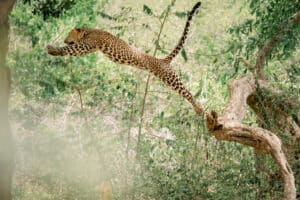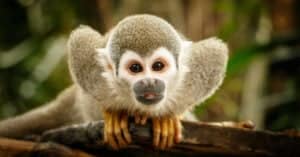Like many wild animals, monkeys can be scary and dangerous. According to the World Health Organization, up to 20% of animal bite injuries are caused by monkeys. Some species can weigh up to 100 pounds, making them even more terrifying. What is it that makes these monkeys so unnerving? Dive in and find out as we discover the 10 most frightening monkeys!
1. Mandrill (Mandrillus sphinx)
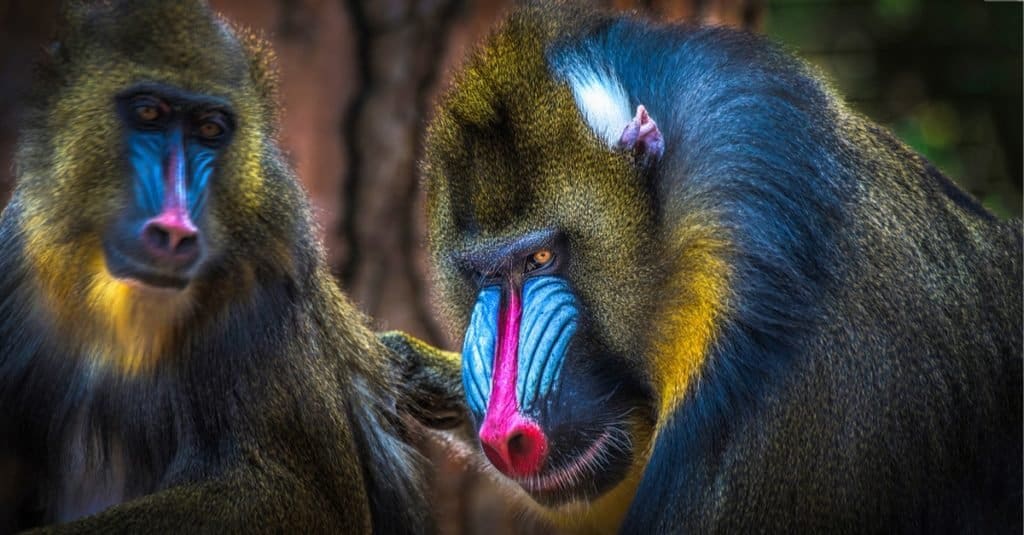
Mandrills are the most colorful monkeys in the world.
©Nikolay 007/Shutterstock.com
Of all the scary monkeys in the world, the mandrill is probably the most frightening. These enormous primates are the largest living monkeys on earth! They grow around 3 feet tall and weigh up to 77 pounds. Mandrills also have powerful and muscular bodies, as well as razor-sharp canine teeth and claws. Their bright red and blue faces and colorful rumps only add to their intimidating appearance. In addition, mandrills are loud and vocal, communicating to one another through deep grunts and high-pitched screams. They are territorial animals that live together in groups from 20 to nearly 1,000. So, you can imagine just how frightening it would be to stumble upon a group of mandrills in the wild!
Fortunately, however, mandrills are not super aggressive, although they definitely will actively defend themselves with vigor if they feel irritated, cornered, or threatened. Their sheer size and weapon-like teeth can do a lot of damage, so it is best to stay away from these colorful monkeys. In addition, they are a vulnerable species.
2. Baboon (Papio)
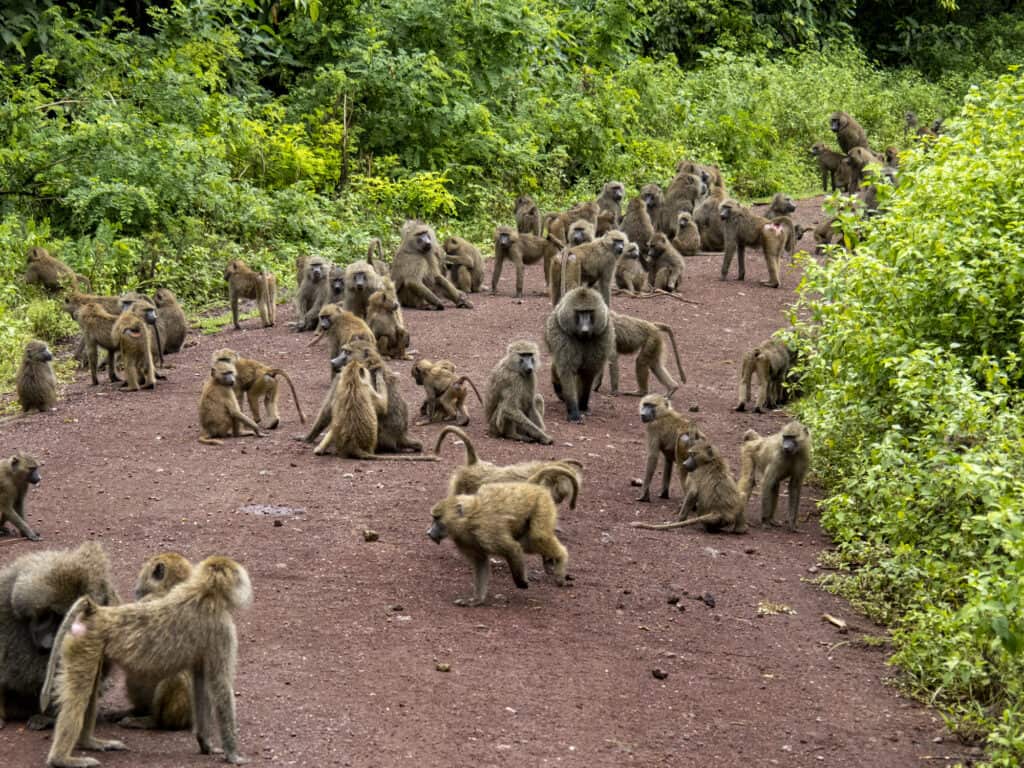
A troop of baboons is a formidable force of nature.
©iStock.com/Elise Morris
Another large and frightening monkey is the baboon, which ranges from 20 to 34 inches long. Its tail is 16 to 23 inches long, and it weighs 33 to 82 pounds. Baboons have large snouts and powerful jaws filled with sharp teeth, which makes them rather worrisome creatures to face.
There are five different species of baboon, all of which live in Arabia and Africa. They are opportunistic and eat anything they can find as they forage for food around the ground. African farmers typically do not like baboons because they are known to eat human crops, and even young sheep or antelopes. Four of the five baboon species live in semiarid regions and savannas. Savannah baboons form large groups called troops, numbering anywhere from a few dozen monkeys to hundreds of these formidable creatures.
3. Drill (Mandrillus leucophaeus)
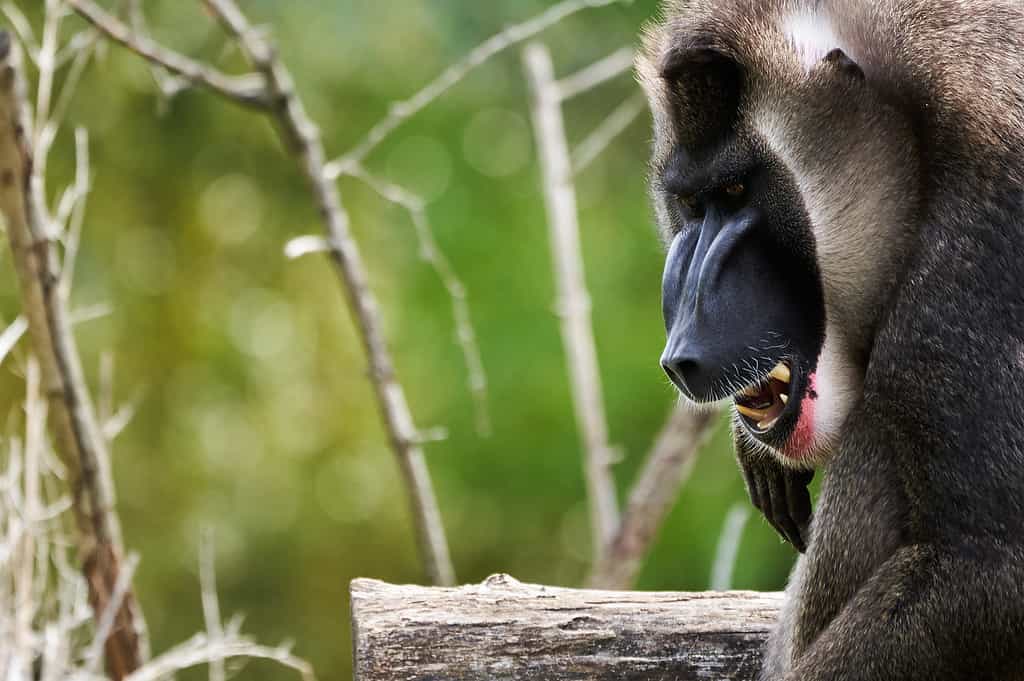
Drills are related to mandrills and baboons.
©Jens Otte/Shutterstock.com
The drill is likely the scariest type of monkey that you’ve never heard of. They are large and forbidding animals, growing up to 28 inches long and weighing 28 to 44 pounds. Closely related to the mandrill, drills have a similar imposing appearance, but without the brightly colored face. Instead, their faces are pitch black. However, drills do have colorful rumps like mandrills, showcasing shades of blue, purple, lilac, pink, and mauve. Male monkeys also have a unique pink or red marking on their lip.
Drills live in groups of 20 to 30 other monkeys, sleeping in trees at night and forging for food on the ground during the day. Sometimes these groups will join forces, and a supergroup of drills could number over 100 monkeys! In addition to their large size, drills have enormous and menacing teeth and sharp canines. They certainly have a terrifying appearance, but it turns out that drills really aren’t aggressive at all! Instead, they are actually quite shy animals that only live in a very remote region of Africa. Sadly, the drill is Africa’s most endangered mammal, and there may be as few as 3,000 left in the wild.
4. Crab-Eating Macaque (Macaca fascicularis)

Some crab-eating macaques have become synanthropic, meaning they feed off human resources.
©silentstock639/iStock via Getty Images
Native to Southeast Asia, crab-eating macaques are very common and can be found in many different habitats. Crab-eating macaques are 15 to 20 inches tall, with a long tail measuring 16 to 20 inches in length. Their arms and legs are relatively short, and they weigh 6.6 to 20 pounds. As omnivorous, crab-eating macaques eat a wide variety of both plants and small animals, but crabs are one of their favorite foods. They have very strong jaws and teeth, which they use to crack open crabs for a delicious snack.
They are also very intelligent animals who are quick to adapt, which is part of the reason they can be so alarming. In fact, in some regions, crab-eating macaques have developed a rather ingenious tactic to get dinner. As humans pass through their territories, the macaques steal various items from them, from water bottles to wallets and cameras. Their human victims, wanting the items back, offer the monkeys food in exchange, so the macaques will barter until they get plenty to eat! Unfortunately, this close contact also brings with it many dangers, as macaques are wild animals. If they feel scared or threatened, they will defend themselves and can cause injury to the humans they are attempting to barter with.
5. Gelada (Theropithecus gelada)
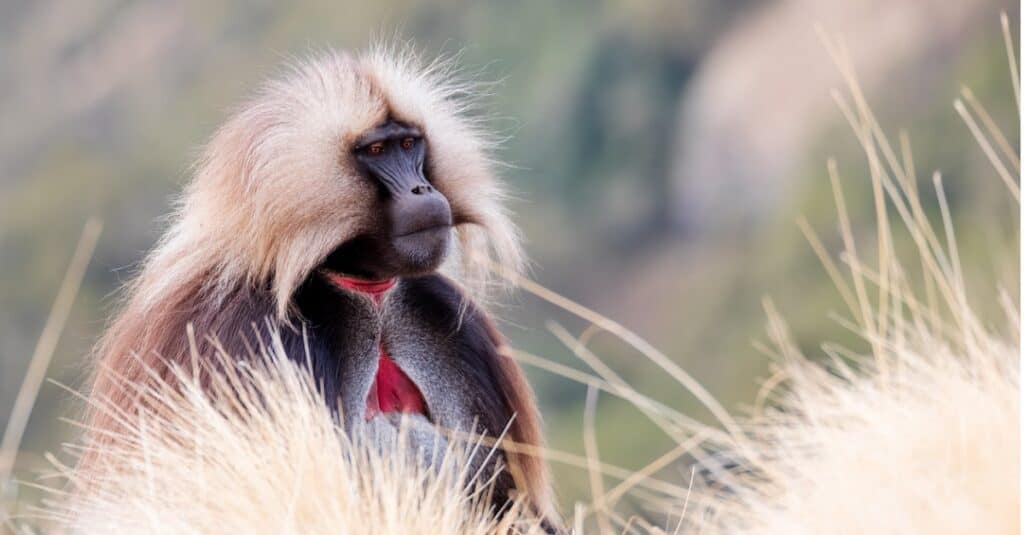
Gelada monkeys have piercing fiery eyes and enormous canines that are very frightening.
©Artush/Shutterstock.com
Also known as a bleeding-heart monkey, the gelada lives in the Ethiopian Highlands. These large monkeys have a rather intimidating presence, with long hair that gives them a somewhat beastly appearance. In fact, their scientific name comes from Greek and means “beast-ape”! Gelada monkeys weigh 24 to 41 pounds on average. They measure 20 to 30 inches long with a 12- to 20-inch-long tail. They are not aggressive, but gelada monkeys certainly have a formidable appearance. With robust bodies and a bright red hourglass or “bleeding-heart” mark on their chests, these monkeys are quite intimidating.
However, geladas are generally peaceful animals. They are also graminivorous, which means that they eat various grasses. Unfortunately, their grass-eating diet has caused some conflict with humans though, as they continue to move closer to farms due to habitat loss and agricultural expansion. Many farmers see geladas as pests and large troops of these monkeys can decimate a great deal of the crops, particularly barley.
6. Howler Monkey (Alouatta)
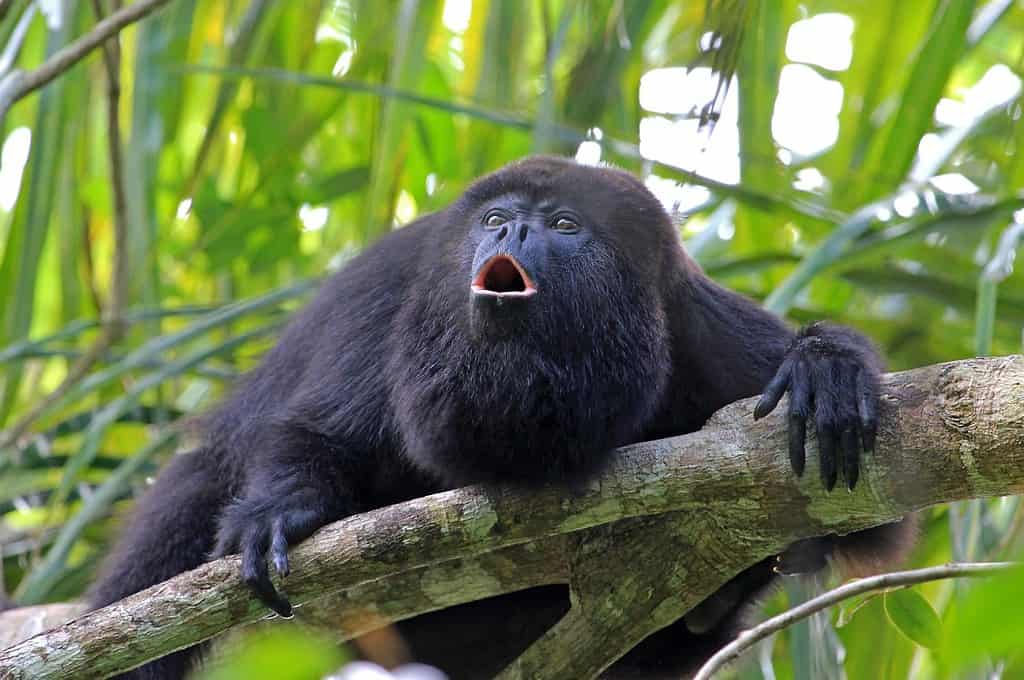
Howler monkeys can smell food over a mile away!
©reisegraf.ch/Shutterstock.com
Native to the forests of South and Central America, howler monkeys can be quite frightening due to their thundering voices. You can hear a howler monkey’s call from three miles away! Due to their special enlarged hyoid bones, howler monkeys can make some truly deafening sounds. They have quite an impressive vocal repertoire as well, with deep, guttural growls that can send chills down your spine. In fact, howler monkeys have such incredible vocals that they hold the title for being the loudest of all land animals!
Howler monkeys are 22 to 36 inches tall. They have very long prehensile tails that can be up to five times their body length. Typically living in groups of six to 15, howler monkeys may be frightening but they are not aggressive.
7. Rhesus Macaque (Macaca mulatta)
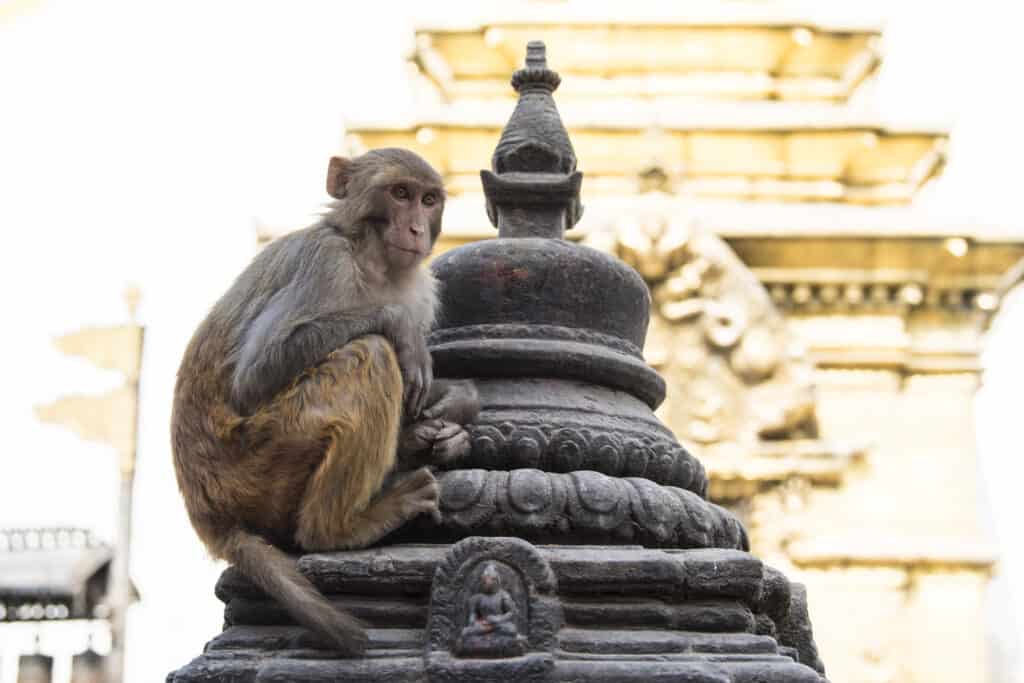
Many rhesus macaques live in or near urban areas.
©iStock.com/3yephotography
Living throughout much of Asia, the rhesus macaque can be found in all kinds of different habitats. It is highly adaptive and there are even feral rhesus macaques living in the United States! Mostly found in Florida, these macaques were introduced by a tour boat operator who wanted to include them in his jungle cruise.
Rhesus macaques are 19 to 21 inches tall and weigh 12 to 17 pounds, typically with brown or gray fur and a pink hairless face. They are very social and gregarious animals, living in troops that range anywhere from 20 to 200 monkeys. For a long time, people believed that rhesus macaques were extremely aggressive, even when unprovoked, but there is actually no verifiable evidence to prove this claim. However, the belief persists, which simply adds to the terror people feel when they see a rhesus macaque and its sharp canine teeth. In addition, many rhesus macaques live near human areas due to the increase of agricultural production, urbanism, and habitat destruction. These macaques can aggressively defend themselves if they feel threatened or cornered.
8. Spider Monkeys (Ateles)
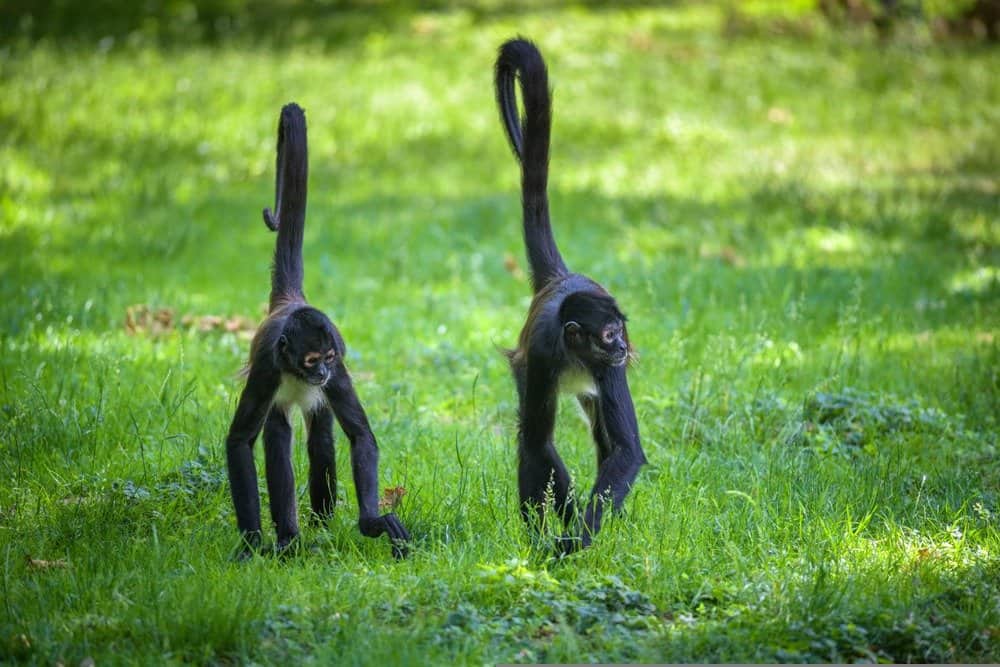
The scientific name of the spider monkey,
Ateles,means “imperfect,” referring to its missing thumbs.
©Nick Fox/Shutterstock.com
With their long arms, legs, and strong tails, spider monkeys truly do look like large furry spiders swinging through the tropical rainforest of South and Central America. Their unique prehensile tail is both long and strong, serving as a fifth leg that can support the monkey’s full body weight. One of the things that really sets spider monkeys apart is that, unlike other monkeys, they don’t have opposable thumbs!
There are several species of spider monkeys, each with large and lanky bodies. The largest species, the black-headed spider monkey, typically weighs 21 to 24 pounds on average, with a long tail up to 35 inches. Spider monkeys live in groups of 15 to 25 other monkeys and have strict territories. They can become aggressive if their personal space is invaded. In addition, spider monkeys are loud and produce many hair-raising sounds.
9. Capuchin Monkeys (Cebinae)

Capuchin monkeys can be territorial and aggressive.
©iStock.com/olm26250
Native to Central and South America, capuchin monkeys have small bodies and bold patterns. They grow 12 to 22 inches and weigh 3 to 9 pounds. Living together in large groups of 10 to 35, capuchins are typically found in forested areas. However, they are quick to adapt and can sometimes be found near urban settlements.
Capuchin monkeys are notorious for their mischievous antics, particularly because they are very smart. However, their high levels of intelligence also make them scary and dangerous monkeys with cunning, strategic plans and attacks. In addition, these cute little monkeys can be very territorial and aggressive. They will scratch and bite when they feel threatened or if they’re trying to protect what’s theirs.
10. Bald Uakari (Cacajao calvus)
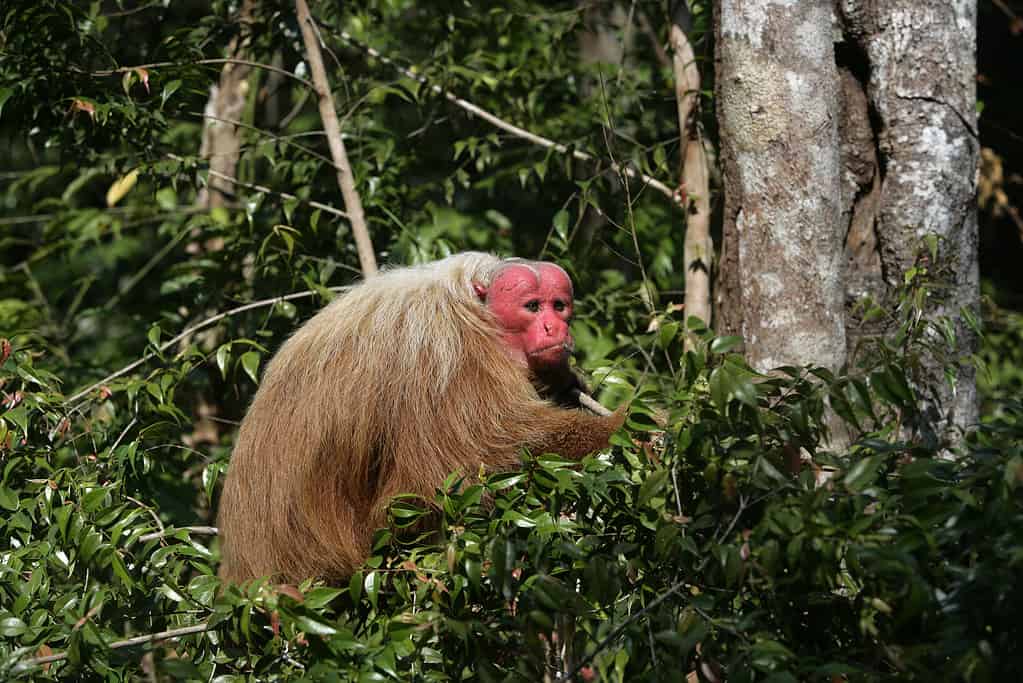
Unfortunately, the bald uakari is a vulnerable species.
©MikeLane45/iStock via Getty Images
The unusual and striking appearance of the uakari monkey is quite frightening to many people. Their bodies are covered in long, shaggy hair, while their heads and faces are completely bald. Despite their large fur coats, uakaris do not accumulate much fat. This makes their bald heads and faces appear skeletal, almost like a vibrant red skull! They have blood vessels close to the surface of their skin, which is what produces such startling color. Just picturing an encounter with one of these monkeys in the wild can produce quite a shock!
Fortunately, however, uakari monkeys are shy, elusive, and non-aggressive. They live in groups numbering up to 100 individuals in the north-western Amazon Basin. Urakaris mainly consume fruit, and can even eat unripe fruit, unlike many other species. In addition, they snack on leaves, buds, flowers, seeds, and sometimes small invertebrates.
The photo featured at the top of this post is © Maciej Kopaniecki/Shutterstock.com
Thank you for reading! Have some feedback for us? Contact the AZ Animals editorial team.




